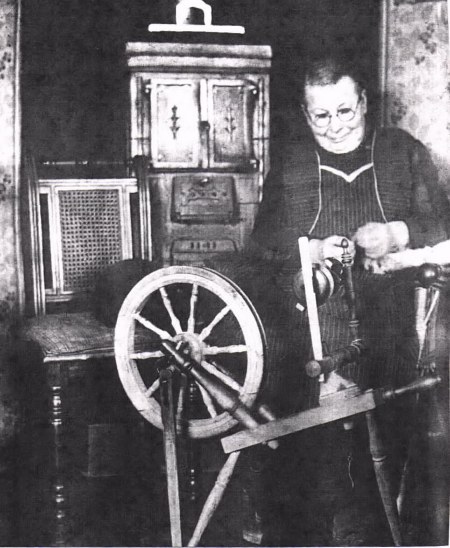| WOOLGATHERERS - Old Fashioned Spinners | ||||||
|
A. Woman Spinning Flax in Typical Lower Saxony Farmhouse. The open fire was in the "kitchen" which opened on the stall area. On the other side of the wall from the fire was the parlor where a two legged iron stove contained warming embers. These are seen in the next two pictures.
 B. Woman Spinning Wool in Schleswig-Holstein parlor. Note that her wheel is more or less the same as above. The two legged cast iron stove "Bilegger" is to be seen in the background. Her cat is on the chair at left.
 C. Carding and Spinning Wool in Schleswig-Holstein parlor. Here are two ladies working with wool together in front of the "Bilegger" stove.
 D. Girls Spinning Flax Outside of Cottage - probably in Lower Saxony. Working together in a group was more sociable than working alone.
 |
I've been asked several times about traditional spinning in Germany with regard to spinning wheels, clothing and setting.
These photos are from our book and photo collection. All are from Northern Germany, but the pictures I've seen from other areas back in the "good old days" are quite similar.
The traditional wheel for spinning flax (and wool) was a smallish Saxony wheel dressed with a distaff for flax and without the distaff for wool. These wheels were generally handmade by local craftsmen and woodworkers, sometimes by family members. Women did not have room or resources for several wheels - as is plain to see in the photos at left.
Flax was dressed on a distaff similar to photos A and D.
Wool was carded into rolags and spun from the hand.
While most people picture the interesting and colorful folklore costumes of the 19th century when they think of Europe, these costumes were worn only for special occasions - and spinning wasn't one of them. When church was over, the good clothes were packed away and the work garments were again put on.
Note that these women are clad almost alike - a long heavy skirt and blouse (sometimes also a vest) were protected by striped or printed aprons. The printed aprons were "Blaudruck" of blue printing done with wood blocks and resist paste using indigo for the blue. Stripes were generally handwoven fabric.
|
